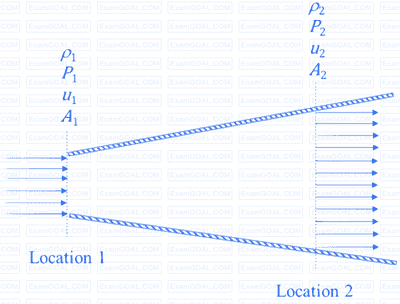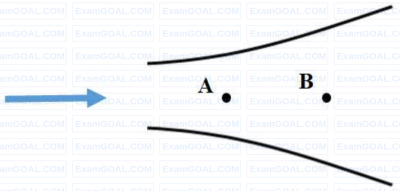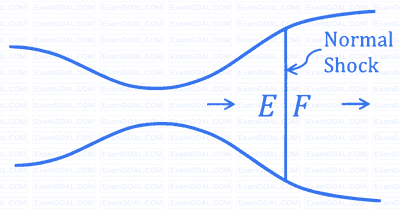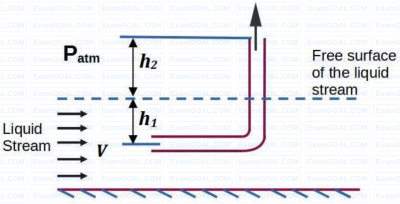Fluid Dynamics · Fluid Mechanics · GATE ME
Marks 1
Consider two identical tanks with a bottom hole of diameter $d$. One tank is filled with water and the other tank is filled with engine oil. The height of the fluid column $h$ is same in both the cases. The fluid exit velocity in the two tanks are $V_1$ and $V_2$. Neglecting all losses, which one of the following options is correct?

Consider an isentropic flow of air (ratio of specific heats = 1.4) through a duct as shown in the figure.
The variations in the flow across the cross-section are negligible. The flow conditions at Location 1 are given as follows:
𝑃1 = 100 kPa, 𝜌1 = 1.2 kg/m3 , 𝑢1= 400 m/s
The duct cross-sectional area at Location 2 is given by A2 = 2A1, where A1 denotes the duct cross-sectional area at Location 1. Which one of the given statements about the velocity 𝑢2 and pressure 𝑃2 at Location 2 is TRUE?

Consider a steady flow through a horizontal divergent channel, as shown in the figure, with the supersonic flow at the inlet. The direction of flow is from left to right.

Pressure at location B is observed to be higher than that at an upstream location A. Which among the following options can be the reason?
In the following two-dimensional momentum equation for natural convection over a surface immersed in a quiescent fluid at temperature T∞ (g is the gravitational acceleration, β is the volumetric thermal expansion coefficient, ν is the kinematic viscosity, u and v are the velocities in x and y directions, respectively, and T is the temperature)
$\rm u \frac{\partial u}{\partial x} + v \frac{\partial u}{\partial y} = g β (T - T_∞) + \nu \frac{\partial^2 u}{\partial y^2} $
the term gβ(T - T∞) represent
The figure shows a purely convergent nozzle with a steady, inviscid compressible flow of an ideal gas with constant thermophysical properties operating under choked condition. The exit plane shown in the figure is located within the nozzle. If the inlet pressure (P0) is increased while keeping the back pressure (Pback) unchanged, which of the following statements is/are true?


State which of the options indicate the correct direction of force for pipe $$1,$$ pipe $$2$$ and pipe $$3.$$

Marks 2
A pitot tube connected to a U-tube mercury manometer measures the speed of air flowing in the wind tunnel as shown in the figure below. The density of air is $1.23 \mathrm{~kg} \mathrm{~m}^{-3}$ while the density of water is $1000 \mathrm{~kg} \mathrm{~m}^{-3}$. For the manometer reading of $h=30 \mathrm{~mm}$ of mercury, the speed of air in the wind tunnel is __________ $\mathrm{m} \mathrm{s}^{-1}$ (rounded off to 1 decimal place).
Assume: Specific gravity of mercury $=13.6$
Acceleration due to gravity $=10 \mathrm{~m} \mathrm{~s}^{-2}$

In the pipe network shown in the figure, all pipes have the same cross-section and can be assumed to have the same friction factor. The pipes connecting points W, N, and S with point J have an equal length L. The pipe connecting points J and E has a length 10L. The pressures at the ends N, E, and S are equal. The flow rate in the pipe connecting W and J is Q. Assume that the fluid flow is steady, incompressible, and the pressure losses at the pipe entrance and junction are negligible. Consider the following statements:
I : The flow rate in pipe connecting J and E is Q/21.
II: The pressure difference between J and N is equal to the pressure difference between J and E.
$$ \text { Which one of the following options is CORRECT? } $$
Steady, compressible flow of air takes place through an adiabatic converging-diverging nozzle, as shown in the figure. For a particular value of pressure difference across the nozzle, a stationary normal shock wave forms in the diverging section of the nozzle. If $E$ and $F$ denote the flow conditions just upstream and downstream of the normal shock, respectively, which of the following statement(s) is/are TRUE?

The velocity field of a certain two-dimensional flow is given by
V(𝑥, 𝑦) = 𝑘(𝑥𝑖̂ − 𝑦𝑗̂)
where 𝑘 = 2 s-1. The coordinates 𝑥 and 𝑦 are in meters. Assume gravitational effects to be negligible.
If the density of the fluid is 1000 kg/m3 and the pressure at the origin is 100 kPa, the pressure at the location (2 m, 2 m) is _____________ kPa.
(Answer in integer)
Consider a unidirectional fluid flow with the velocity field given by
V(𝑥, 𝑦, 𝑧, 𝑡) = 𝑢(𝑥, 𝑡) 𝑖̂
where 𝑢(0,𝑡) = 1. If the spatially homogeneous density field varies with time 𝑡 as
𝜌(𝑡) = 1 + 0.2𝑒−𝑡
the value of 𝑢(2, 1) is ______________. (Rounded off to two decimal places) Assume all quantities to be dimensionless.
An explosion at time t = 0 releases energy 𝐸 at the origin in a space filled with a gas of density ρ. Subsequently, a hemispherical blast wave propagates radially outwards as shown in the figure.
Let R denote the radius of the front of the hemispherical blast wave. The radius R follows the relationship 𝑅 = 𝑘 𝑡𝑎 𝐸 𝑏 𝜌𝑐, where k is a dimensionless constant. The value of exponent a is ___________.
(Rounded off to one decimal place)

A tube of uniform diameter D is immersed in a steady flowing inviscid liquid stream of velocity V, as shown in the figure. Gravitational acceleration is represented by g. The volume flow rate through the tube is ______.



Density of water is $$1000\,\,kg/{m^3}.$$
Acceleration due to gravity $$g = 10\,\,m/{s^2}.$$




$${S_1}\,\,$$ (elevation : $$10$$ $$m$$ ) is the $$50$$ $$kPa.$$ At section
$${S_2}\,\,$$ (elevation : $$12$$ $$m$$ ) the pressure is $$20$$ $$kPa$$ and velocity is $$2$$ $$m/s.$$
Density of water is $$1000$$ $$kg/{m^3}$$ and acceleration due to gravity is $$9.8$$ $$m{s^{ - 2}}.$$ Which of the following is TRUE?






Marks 3
Marks 5

At inlet: $$\,\,\,\,\,\,\,$$$$\,\,\,\,\,\,\,$$$$\,\,\,\,\,\,\,$$$$\,\,\,\,\,\,\,$$$$\,\,\,\,\,\,\,$$$$\,\,\,\,\,\,\,$$ At outlet:
$${A_1} = {10^{ - 3}}{m^2};\,$$ $$\,\,\,\,\,\,\,$$$$\,\,\,\,\,\,\,$$$$\,\,\,\,\,\,\,$$ $${A_2} = {10^{ - 4}}{m^2};$$
$${V_1} = 2\,m/\sec ;$$ $$\,\,\,\,\,\,\,$$$$\,\,\,\,\,\,\,$$$$\,\,\,\,\,\,\,$$$$\,\,\,\,\,\,\,$$ $${P_2} = {P_{atm}}$$
$${P_1} = 3 \times {10^5}\,Pa\,(gauge)$$
Determine the external horizontal force needed to keep the nozzle

$${V_1} = 20\,\,m/s,\,\,$$
$${V_2} = 10\,\,m/s,\,\,$$
$${A_1} = 0.01\,\,{m^2},\,$$
$$\,{A_2} = 0.02\,{m^2},$$
density of water $$\rho = 1000kg/{m^3}.$$


(a) Pressure at $$A,$$
(b) The velocity of flow of saline through the tube. (Neglect viscous losses in tube). Atmospheric pressure $${P_{atm}}.$$

(a) the force experienced by the vane, and
(b) the power developed by the vane.